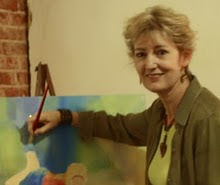Painting a House Portrait Lesson Three: The Final Stage -- the Watercolor Wash
If you have decided to paint house portraits, this series of lessons is your step by step guide.
Lesson #1 taught you how to plan out your house portrait, choosing your subject and taking photographs. Lesson #2 walked you through pen drawing stage. This final lesson teaches you to complete your work of art with a watercolor wash of the pen drawing.
As I stated in an earlier lesson, you can of course use any method you choose to represent your house -- from oil paints to pastels -- but from my experience, certain mediums work better than others for house portraits. My preference for house portraits is a pen drawing followed by a watercolor wash. The line drawing records the finer points of the house and the garden while the watercolor wash or painting really brings it to life. This enables you as the artist to create a detailed, attractive but subtle representation of the home and its garden surroundings.
Now that you have your house portrait drawn out, including all the lines and shading, so that it has contrast and dept, it is time apply the last step – the watercolor wash. There are specific skills regarding watercolor painting techniques and obviously the purpose of these lessons is not to teach you these, but give you the simple steps that you can take to produce your own house portrait. There are however there are many books, tutorials, and step by step videos available on watercolor painting.
Firstly lay out small amounts of the colors that you will need on your watercolor palette. Have your source photo at hand so you can clearly see the colors of your house portrait. You will need a container of water and different sizes of paintbrushes, finer for the details and broader for the larger areas such as the sky, lawn and garden areas.
As per watercolor technique one usually starts with the larger areas first. Once these areas dry, fill in the shadows, deeper tones and details to create contrast. You will find that with a straight watercolor painting, where there is no pen work to follow, you will need to do many more layers of watercolor to get the depth and detail needed. Remember however that while the pen lines and shading does a lot of the work for you, to make your painting attractive you still need to use those basic watercolor techniques. But don’t overdo the watercolor wash either. It needs to be translucent so you can still see the pen work underneath. Otherwise, what’s the point of doing the pen work in the first place? One tip I can give on translucency is the use of acrylic paint rather than watercolor paint. In this case, one uses acrylic paint -- which is water based of course -- in exactly the same way as watercolor paint, but simply adds a lot more water than is usually used for acrylic painting.
In summary, you want the watercolor wash to add character and capture the personality of the home. With the pen and watercolor wash technique you are combining two distinct art forms, pen drawing and watercolor painting and if done well the result can be a vibrant mix of detail, accuracy and color. Don’t forget that any skill or art form takes practice and patience.
Good luck in creating your first house portrait!
About Leisa Collins:
Leisa's artistic motto is Art with a Message. Her website stresses the importance of artists creating social change and includes an online gallery of landscapes and portraits. She specializes in house portraits, pet portraits, child portraits and original landscape paintings.
Contact Info:
Send an email
www.leisacollins.com





